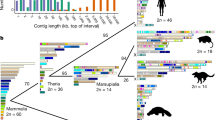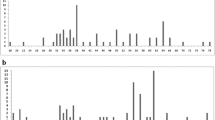Summary
Tympanoctomys barrerae, a desert specialist member of the family Octodontidae, until now thought to be conservative, and ancestral to South American hystricognath rodents, presents the highest diploid chromosome number (2n=102) known in a mammal. Unexpectedly, its karyotype was found to be composed mainly of metacentric to sub-metacentric chromosomes. Mechanisms by which such a karyotype may have been derived are discussed.
Similar content being viewed by others
References
Honacki, J. H., Kinman, K. E., and Koeple, J. W., Mammal Species of the World. Allen Press Inc. and The Assoc. Syst. Coll., Lawrence, Kansas 1982.
Patterson, B., and Wood, A. E., Bull. Mus. comp. Zool.120 (1982) 279.
Mares, M. A., and Ojeda, R. A., in: Mammalian Biology, in: South America, vol. 6, p. 393. Eds M. A. Mares and H. H. Genoways. Pymatuning Lab. Ecol, Linesville, Pennsylvania 1982.
Contreras, L. C., Torres-Mura, J. C., and Yañez, J. L., in: Studies in Neotropical Mammalogy: Essays in honor of Phillip Herskovitz, p. 401. Eds B. D. Patterson and R. M. Timm. Fieldiana, Zool. new ser.39 (1987).
De La Barrera, J. M., Revta Inst. Bact.9 (1940) 565.
Lawrence, B., Proc. New Engl. Zool. Club18 (1941) 43.
Yepes, J., Revta Argent. Zoogeogr.2 (1942) 69.
Hsu, T. C., and Patton, J. L., in: Comparative Mammalian Cytogenetics. Ed. K. Benirschke. Springer Verlag, New York 1969.
Summer, A. T., Exp. Cell Res.75 (1972) 304.
Spotorno, A. E., in: El Nucleo los Cromosomas y la Evolución, p. 133. Ed. R. Fernandez-Donoso. Unesco, Santiago 1985.
Fernandez, R., Archos Biol. Med. exp (Santiago)5 (1968) 33.
George, W., and Weir, B., Chromosoma37 (1972) 53.
Reig, O. A., Spotorno, A., and Fernandez, R., Biol. J. Linn. Soc.4, (1972) 29.
Venegas, W., Boln Soc. Biol. Concepción47 (1974) 207.
Venegas, W., Boln Soc. Biol. Concepción49 (1975) 7.
George, W., and Weir, B. J., in: The Biology of Hystricomorph Rodents, p. 79. Eds I. W. Rowlands and B. J. Weir. Symp. Zool. Soc., London 1974.
Imai, H. T., and Crozier, R. H., Am. Nat.116 (1980) 537.
Chiarelli, A. B., and Capanna, E., Cytotaxonomy and Vertebrate Evolution. Academic Press, London 1973.
Torres-Mura, J. C., Lemus, M. L., and Contreras, L. C., J. Mammal.70 (1989) 646.
Mazrimas, J. A. and Hatch, F. T., Nature240 (1972) 102.
Ohno, S., Becak, W., and Becak, M. L., Chromosoma15 (1964) 14.
Shi, L. M., Ye, Y., and Duan, X., Cytogenet. Cell Genet.26 (1980) 22.
Levan, A., Fredga, K., and Sandberg, A. A., Hereditas52 (1964) 201.
Spotorno, A. E., Walker, L., Contreras, L. C., Pincheira, J. and Fernandez, D. R., Archos Biol Med. exp.21 (1988) R527.
Contreras, L. C., Silva, S., Torres-Mura, J. C. and Spotorno, A. E., Archos Biol. Med. exp.21 (1988) R527.
Author information
Authors and Affiliations
Rights and permissions
About this article
Cite this article
Contreras, L.C., Torres-Mura, J.C. & Spotorno, A.E. The largest known chromosome number for a mammal, in a South American desert rodent. Experientia 46, 506–508 (1990). https://doi.org/10.1007/BF01954248
Received:
Accepted:
Published:
Issue Date:
DOI: https://doi.org/10.1007/BF01954248




